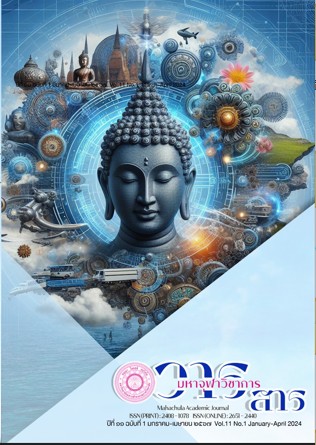Guidelines for Application of the Four PatฺIsambhidã for the Buddhism Propagation Through Thailand Radio Broadcating Media of Thong-Buddho Program
Main Article Content
Abstract
In this research, three objectives were purposely made: (1) to study the problematic state of information communication in propagation of Buddhism through radio broadcasting of Buddha's recitation program (Tong Buddho channel), (2) to study the principles of four Patฺisambhidã according to Theravada Buddhism, and (3) to present the guidelines for communicating information according to the four Patฺisambhidãs for the propagation of Buddhism through radio broadcasting in Thailand of Buddha's recitation program called Thong Buddho Program. This research employed a qualitative research methodology done by studying documents and in-depth interviews with 10 interviewees, consisting of 2 ordained monks and 8 laypeople. The results of the research showed the problematic states of communicating information in the propagation of Buddhism through radio broadcasting were divided into 4 aspects: 1) the problems are caused by a sender of messages, that is, a sender has no proper knowledge on Buddhism resulting in berefting of neutrality, 2) the problems are caused by messages, that are, its contents are difficult and far-fetched with other hidden objectives, 3) the problems are caused by channel, that is, there are few Dhamma programs, limited time, and no sponsors. Therefore, it was ignored because it did not meet the business needs, and 4) the problems are caused by receiver of messages, that are, the listeners have no knowledge and thereby demanding high expectations giving rise to the indistinguishability between faith and superstition.
As far as four principles of Patฺisambhidã in Theravada Buddhism are concerned, they are of the followings: 1) Attha- Patฺisambhidã, 2) Dhamma- Patฺisambhidã, 3) Nirutti- Patฺisambhidã, and 4) Patฺibhãnฺa- Patฺisambhidã from the academic point of view, the concepts for application are as follows: 1) Attha- Patฺisambhidã (true knowledge content), 2) Dhamma- Patฺisambhidã (comprehending the point), 3) Nirutti- Patฺisambhidã (rhetoric), 4. Patฺibhãnฺa- Patฺisambhidã (Have a flair for presenting and answering questions). When it comes to guidelines for communicating information according to the concept of interaction four Patฺisambhidã for the propagation of Buddhism through radio broadcasting in Thailand, they are of: 1) the guideline for communicating information according to the four Patฺisambhidã principles, i.e. studying information to understand its contents, capture issues, rhetorically communicate in the language, and create new knowledge in accordance with the situation, 2) the presenter's practice is to study and gain knowledge where they should not distort information in order to know the target audience, conveying the correct teachings according to the Scriptures with references, and 3) the recommendation is to create a new generation to join as a moderator of supplementary programs where editing guest videos, posting them on online platforms, and arranging Dharma activities to maintain the audience bases are carried out.
Article Details

This work is licensed under a Creative Commons Attribution-NonCommercial-NoDerivatives 4.0 International License.
References
กุลกนิษฐ์ ทองเงา และคณะ. “วิทยุกระจายเสียงเพื่อการศึกษาโลกแห่งเทคโนโลยีอนาคต”. วารสารวิทยบริการ. ปีที่ ๒๑ ฉบับที่ ๑ (มกราคม-เมษายน ๒๕๕๓) : ๑-๒๒.
ซาริสวิณี รัตนบุรี. “แนวทางการนำหลักปฏิสัมภิทามาใช้ในการอธิบายธรรมะ”. วารสาร มจร พุทธโสธรปริทรรน์. ปีที่ ๒ ฉบับที่ ๑ (มกราคม-มิถุนายน ๒๕๖๕) : ๓๘.
ธนิพร จุลศักดิ์. “การเผยแผ่ธรรมะผ่านสื่อสังคมออนไลน์ ของพระมหาวุฒิชัย วชิรเมธี”. วิทยานิพนธ์นิเทศศาสตรมหาบัณฑิต สาขานิเทศศาสตรธุรกิจ. บัณฑิตวิทยาลัย: มหาวิทยาลัยธุรกิจบัณฑิตย์, ๒๕๕๕.
นงค์นาถ ห่านวิไล. “แนวทางการเสริมสร้างจริยธรรมสื่อมวลชนไทยเชิงพุทธบูรณาการ”. วารสารร่มพฤกษ์ มหาวิทยาลัยเกริก. ปีที่ ๓๖ ฉบับที่ ๑ (มกราคม-เมษายน ๒๕๖๑) : ๑๔๙.
ปุญย์ธนิตา วากะดวน. “การประยุกต์ใช้พุทธจริยธรรมสำหรับสื่อมวลชนด้านศาสนาในสังคมปัจจุบัน”. วิทยานิพนธ์พุทธศาสตรมหาบัณฑิต สาขาวิชาพระพุทธศาสนา. บัณฑิตวิทยาลัย: มหาจุฬาลงกรณราชวิทยาลัย, ๒๕๖๔.
พระครูโสภณธรรมวิภัช เอี่ยมบึงลำ และคณะ. “พัฒนาคู่มือการจัดรายการวิทยุเพื่อการเผยแผ่พระ พุทธศาสนาของนักจัดรายการวิทยุในเขตภาคเหนือตอนล่าง”. วารสารศึกษาศาสตร์ มหาวิทยาลัยนเรศวร. ปีที่ ๒๑ ฉบับที่ ๒ (เมษายน-มิถุนายน ๒๕๖๒) : ๑๙๓-๑๙๔.
พระปลัดสุระ ญาณธโร. “ประโยชน์ที่ได้รับจากการศึกษาพระไตรปิฎก: ด้านคติธรรมและสหธรรม”. วารสารมหาจุฬาคชสาร. ปีที่ ๙ ฉบับที่ ๒ (กรกฎาคม-ธันวาคม ๒๕๖๑) : ๑๓๕.
พระพรหมคุณาภรณ์ (ป. อ. ปยุตฺโต). พจนานุกรมพุทธศาสตร์ฉบับประมวลธรรม. พิมพ์ครั้งที่ ๑๐.กรุงเทพมหานคร: เอส.อาร์.พริ้นติ้ง แมส โปรดักส์จำกัด, ๒๕๔๕.
พระพุทธโฆสเถระ. คัมภีร์วิสุทธิมรรค. แปลและเรียบเรียงโดย สมเด็จพระพุฒาจารย์ (อาจ อาสภมหาเถร). พิมพ์ครั้งที่ ๕. กรุงเทพมหานคร: บริษัท ประยูรวงศ์พริ้นท์ติ้ง จำกัด, ๒๕๔๗.
พระไพศาล วิสาโล. “เทคโนโลยีสารสนเทศและการสื่อสารกับพระพุทธศาสนา”. การประชุมทางวิชาการเทคโนโลยีสารสนเทศและการสื่อสารเพื่อความเท่าเทียมกันประจำปี ๒๕๕๕. ๒๔ พฤศจิกายน พ.ศ. ๒๕๕๕, วิทยาลัยเทคโนโลยีปัญญาภิวัฒน์ จังหวัดนนทบุรี.
พระมหาถาวร ถาวรเมธี (ภูแผลงทอง). “คุณสมบัติของครูผู้สอนตามแนวพุทธธรรม”. วารสารบัณฑิต ศึกษาปริทรรศน์วิทยาลัยสงฆ์นครสวรรค์. ปีที่ ๘ ฉบับที่ ๑ (มกราคม-เมษายน ๒๕๖๓) : ๒๘๗.
พระมหาบุญทิน ปุญฺญธโช (เทาศิริ). “กลยุทธ์การเผยแผ่พระพุทธศาสนาตามหลักปฏิสัมภิทา ๔ สำหรับ พระธรรมทูตไทยในทวีปยุโรป”. วารสารมหาจุฬานาครทรรศน์. ปีที่ ๖ ฉบับที่ ๑ (สิงหาคม ๒๕๖๒) : ๓๑๖๒-๓๑๖๕.
มหาจุฬาลงกรณราชวิทยาลัย. พระไตรปิฎกภาษาไทย ฉบับมหาจุฬาลงกรณราชวิทยาลัย. กรุงเทพมหานคร: โรงพิมพ์มหาจุฬาลงกรณราชวิทยาลัย, ๒๕๓๙.
ศิริพร วงศ์สวัสดิ์. “รูปแบบการใช้เสียงในการเผยแผ่พระพุทธศาสนา”. วารสารมหาจุฬาวิชาการ. ปีที่ ๒ ฉบับที่ ๑ (มกราคม-มิถุนายน ๒๕๕๘) : ๑๔๐.
มติชนออนไลน์. “พระคติธรรมวันมาฆบูชา. “ไม่กล่าวร้าย ไม่ทำร้าย” เป็นพื้นฐานการครองตนในสังคมที่เต็มไปด้วยข้อมูลข่าวสารเท็จ”. [ออนไลน์]. แหล่งที่มา: https://www.matichon. co.th/education/ news_1950966v [๒๙ สิงหาคม ๒๕๖๕].


